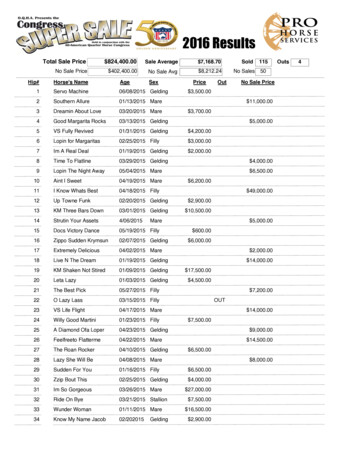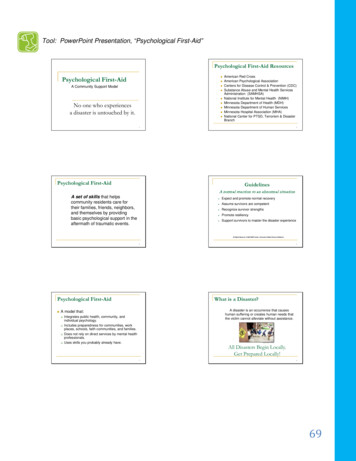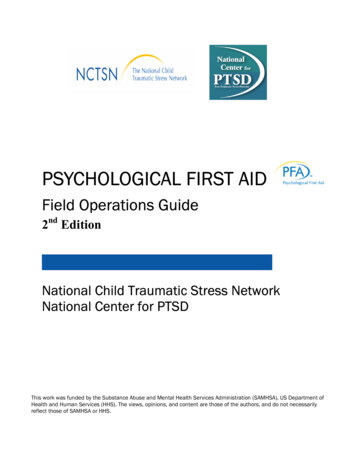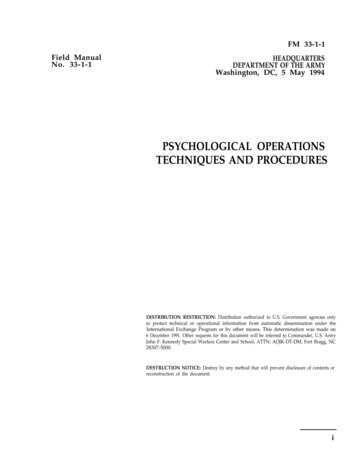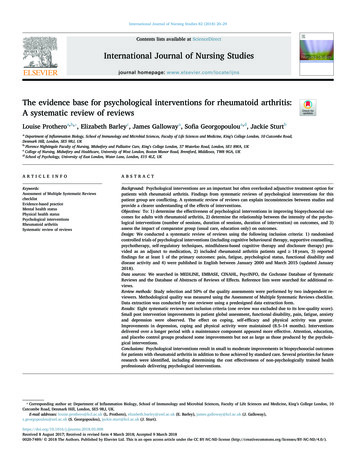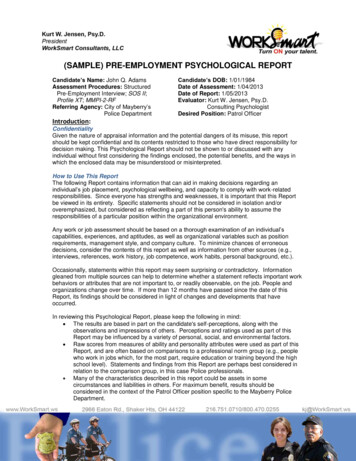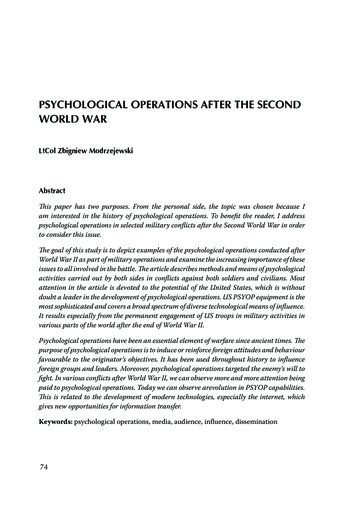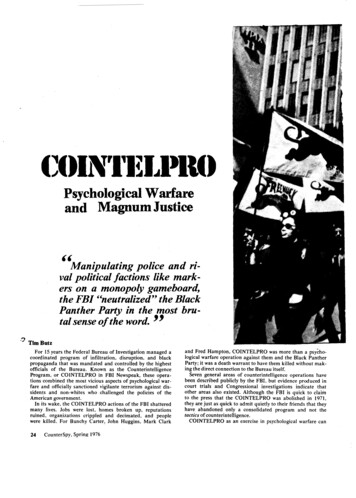
Transcription
Psychological W mareand MagnumJustice"Manipulating poliee and rival politieal faetions like markers on a monopoly gameboard,the FBI "neutralized" the BlaekPanther Party in the most brutal sense of the word. ".?Tim ButzFor IS years the Federal Bureau of Investigation managed acoordinated program of infiltration, disruption, and blackpropaganda that was mandated and controlled by the highestofficials of the Bureau. Known as the CounterintelligenceProgram, or COINTELPRO in FBI Newspeak, these operations combined the most vicious aspects of psychological warfare and officially sanctioned vigilante terrorism against dissidents and non-whites who challenged the policies of theAmerican government.In its wake, the COINTELPRO actions of the FBI shatteredmany Iives. Jobs were lost, hornes broken up, reputationsruined, organizations crippled and decimated, and peoplewere kilIed. For Bunchy Carter, John Huggins, Mark Clark24CounterSpy, Spring 1976and Fred Hampton, COINTELPRO was more than a psychological warfare operation against them and the Black PantherParty; it was a death warrant to have them kilIed without making the direct connection to the Bureau itse1f.Seven general areas of counterintelligence operations havebeen described publicly by the FBI, but evidence produced incourt trials and Congressional investigations indicate thatother areas also existed. AIthough the FBI is quick to claimto the press that the COINTELPRO was abolished in 1971,they ar,ejust as quick to admit quietly to their friends that theyhave abandoned only a consolidated pro gram and not thetactics of counterintelligence.COINTEL PRO as an exercise in psychological warfare can
best be understood by comparing its stated purpose with themilitary, Psy-War purpose. According to internal FBI memoranda, the Counterintelligence Program was designed to "expose, disrupt, and neutralize" targeted groups through the useof rumors, lies, half truths and government "front" organizations. COINTELPRO could be termed a "dis-information"program.Psychologie al warfare is similarly defined by the Departmentof Defense and the Joint Chiefs of Staff in the official DoDDictionary 01 Military and Associated Terms: psychologicalwarfare is the "planned use of propaganda and other measuresdesigned to influence the opinions, emotions, attitude, and behavior of enemy, neutral, or friendly groups in support of cur-rent policy and aims." A look at the major com ponents ofCOINTELPRO show that it is compatable with this definitionof psychological warfare.The use of rumors, lies, and half truths is commonly caUed"black propaganda operations," and is a weH establishedcustom within the intelligence community. The FBI usedblack propaganda, which was anational choice of tactics giventhe goal of COINTELPRO to neutralize the opposition bymanufacturing or exploiting weaknesses. The V.S. Armyteaches students at the Army Special Warfare Center at FortBragg that " . vulnerabilities can best be exploited by meansof black propaganda . and (it) requires great care andsecrecy . "Spring 1976, CounterSpy25
Great care and secrecy were the watch words of COINTELPRO. Had it not been for the burglary of the FBI Resident.Agency office in Media, Pa., on March 8, 1971. the existenceof COINTELPRO may have never been uncovered. In thatburglary, internal FBI memos were stolen and later releasedto the press. An analysis of the documents showed that 45 percent of the FBI memos dealt with criminal activities, 1 percentwith organized crime, 14 percent with draft and military resistance to the Vietnam War, and 40 percent with other politicalactivities. Among the political activities documents wereseveral relating to the CounterinteIligence Program. An orderto terminate COINTELPRO came within six weeks of theburglary, shortly after the documents were released to thepress.NBC reporter Carl Stern read the Media Papers and, sensingan important story, he filed a Freedom of Information requestfor the documents authorizing the program. After a two-yearlegal battIe, the FBI released some of the documents to Stern.Stern's attorney, Ronald Plessar, pursued the matter and finally forced the Bureau to release a second series of documents.From Plessar and Stern's work came the first flood ofinformation on COINTELPRO.Since the first documents released to Stern and Plessar onDecember 7, 1973, there have been two major lawsuits focusedon COINTELPRO. One suit has been brought by the SocialistWorkers Party and Young Socialist Alliance against the FBI,CIA, and various government officials. The second suit wasbrought by the survivors of the December 4, 1969 raid on aBlack Panther Party apartment and the relatives of two menkilled in the raid, Mark C1ark and Fred Hampton. The recentHouse and Senate inteIligence investigations revealed a massof previously unknown facts around the FBI and COINTELPRO. From these major sources, it is possible to see howCOINTELPRO developed as a psychological warfare activity.How COINTELPRO BeganThe first FBI counterintelIigence operation was initiated in1956 and targeted against the Community Party-USA (CPUSA). According to former Attorney General Saxbe, the effortwas justified by a "prevailing view in Congress and the American people that the Federal Government should take appropriate steps against domestic subversion." Perhaps the realreason was J. Edgar Hoover's personal dissatisfaction andfrustration with the failure ofthe government to imprison communists. The Smith Act, designed to destroy the CP-USA andthe Socialist Workers Party, had failed in its goals. Of 141people indicted under the Smith Act, only 29 ever served timein prison. When the Suprethe Court ruled in 1957 that advocacy of a doctrine or "evil intent" was still covered by theFirst Amendment, the Smith Act lost its main thrust. It became c1ear to Hoover that other steps had to be taken.It was easy for the FBI to develop information for a CP-USACOINTELPRO: of an estimated 8,500 members, 1,500 ofthemwere FBI informants and provided a wealth of information onParty structure, finances, and the personal lives of the membership. Hoover finally had to order his agents not to recruitany more informants unless they were in "the highest policymaking levels" ofthe Party. On August 28, 1956, the CP-USAbegan.One "high level" informant was a Security Officer in theCentral Committee of the CP-USA. According to former FBIagent Jack Levine, the Security Officer was responsible fordiscrediting loyal Party members and granting cIearances toothers who were actually FBI plants. This tactic was one of.many the Justice Department later admitted was a COINTEL-26CounterSpy, SprinR 1976PRO action.On October 12, 1961, the FBI turned its sights on the Socialist Workers Party (SWP). According to a memo signed byHoover, the SWP's sins incIuded their support of "Castro'sCuba", integration, and their sponsoring socialist candidatesin local and national elections.The next target group became those the Bureau termed"White Hate Groups." Seventeen Ku Klux Klan chapterswere targeted for COINTELPRO operations under a memorandum that incIuded a subtle note of apology. As if to saythat the problem might simply be a few bad apples in the barrel, Hoover wrote: "Often these groups act without the approval of the Klan organization or membership" when conducting attacks on civil rights workers and Blacks.With the expansion of the civil rights movement and theemergence of nationalism among Blacks, Hoover orderedthe FBI to target "Black Nationalist - Hate Groups" for coun·terinteIligence disruption. In an August 25, 1967, memo,Hoover outIined the goals of the .newest COINTELPRO: "toexpose, disrupt, misdirect, or otherwise neutralize the activities of black nationalist, hate-type organizations and group·ings, their leadership, spokesmen, membership, and supporters . "Six months later, on February 29, 1968, Hoover expandedthe Bureau's position on the COINTELPRO·Black Nationalistprogram with a memo that outlined five specific goals:(1) Prevent coalitions of Black groups;(2) Prevent the rise of a Black "messiah", such as MartinLuther King, Stokely Carmichael, and Elijah Mohammud;(3) Prevent violence;(4) Prevent Black groups and leaders "from gaining respectability";(5) Prevent the long-range growth of Black groups, especiallyin their recruitment of youth.A few weeks after Hoover's memo, one of his major adversaries was eliminated. Dr. Martin Luther King, the subjectof a seven-year Bureau campaign of wiretapping and harrassment, was kilIed by a sniper in a Memphis hotel. King hadchanged his hotel after the FBI planted a story in the localpress that he was Iiving in a Holiday Inn rather than in a localBlack-owned hotel. Deliberate or not, the FBI set Dr. King upfor his assassination.In May, 1968, the FBI began a fifth domestic counterintelIigence effort, this time targeted against the predominatelywhite New Left. The goals were the same: the use of propaganda and other disruptive measures to neutralize an FBIenemy.Each of the CounterintelIigence Programs operated along thesame basic Iines. At each participating field office (not alloffices were involved with every program), a counterintelligence coordinator was selected and charged with supervisionof the program 10caIly. It was the coordinator's job to identifypotential weaknesses within the target grouping and devisethe proper technique to create the desired disruption orneutralization.Recommendations for counterinteIligence actions were thenprepared with descriptions of the target group, the action tobe taken, and desired results. This letter was then sent to FBIHeadquarters in Washington, D.C., where they were eitherapproved or rejected. The official primarily responsible forCOINTELPRO was WiIliam SuIlivan, who in 1961 became theAssistant Director in charge of the InteIligence Division, andhis deputy, CharIes D. Brennan.The field office coordinators also provided SuIlivan anc.tBrennan with quarterly status reports on the progress ofCOINTELPRO activities in their areas. These r ports broke
COINTELPRO information into four areas: actions pending,actions in progress, actions completed and their resuIts, andmiscellaneous information.This structure and reporting system provided a simple butefficient bureaucratic mechanism for strict control over theprogram. Headquarters constantly warned field offices to avoidany form of counterinteIligenceactivity without specific authorization from Washington. Under this system of reports, proposals, and evaluation, 3,247 counterintelligence actions wereconsidered and 2,370 were conducted.In his testimony before the Senate Select Committee on Intelligence, Deputy Associate Director James B. Adams statedthat COINTELPRO actions "were not designed for the purpose of harrassment of an individual . they were designed todisrupt groups." In order to conduct the disruptions, the FBIused the oldest psy-war tactic, the manipulation of information.Spreading Black PropagandaThe most popular tactic was the manufacturing of false andanonymous information and distributing it in such a way asto create or aggrevate tension. This tactic accounted for a full40 percent of all FBI COINTELPRO actions. On one occasion,the Bureau decided to disseminate false information to members of the Oakland, Ca., chapter of the Black Panther Partyby fabricating an anonymous "Ieak" within the Oakland orSan Francisco Police departments. The purpose of the falseleak was to make the Panthers think that the leade.rship wasstealing Party funds, that wiretaps were installed in piaceswhere none existed, that loyal members were informants, andother lies designed to promote factionalism.The tactic of framing Party members as informers was notIimited to the Panthers. The FBI used that tactic against boththe Communist Party and the New Left.A variation of this tactic was often used to split Black andWhite movement groups from cooperating and coalescing.In 1969, the FBI used an informant, in the Black United Frontof Washington, D.C., to make false moneydemands from theNew Mobilization Committee to End the War in Vietnam. Ina manufactured letter, the FBI demanded the "Mobe" posta high cash bond to insure that Washington's black community would not be harmed by the demonstration. That action succeeded in creating tension between the Mobilizationcommittee and the Black United Front and diverting energyfrom building the largest anti-war demonstration ofthe 1960's.Such black propaganda was also used to create friction between the Students for a Democratic Society (SDS) and theBlack Panther Party. Selected informants within the IIlinoisChapter of the Panthers were instructed to create' a dynamic,through the use of lies, that would stop the Panthers and SDSfrom working in a pdlitical coalition.Organizations can sometimes be crippled by the use of aCounterintelligence technique against a key individual. InSt. Louis, the FBI attempted to stop a white woman who wasworking with a predominately Black neighborhood group. Inorder to neutralize her, the Bureau sent an anonymous letterto the woman's husband alleging infidelity and aduItery. Theletter was written in street language and purported to be from"some Black sisters"; it complained that the woman wassleeping with "their" men.The second most popular tactic used in COINTELPRO wasthe dissemination of confidential and semi-public informationto friendly sources within the media. As the final report of theSenate Select Committee on Intelligence points out, the FBIfor ears had developed a media liaison program that allowedthem to use journalists as inteIligence sources and as activeagents in distributing FBI black propaganda.The purpose of this type of action was to embarrass (and(herefore affect the political power 00 key movement activists.The most notorious examples of this were in connection withthe Bureau's attempts to discredit and even blackmail Dr.Martin Luther King through the use of tapes made of Dr.King's private Iife. At one point, Senate investigators foundthat the FBI had gone se far as to even suggest to Dr. King thathe should commit 'suicide several weeks before he was to travelto Stockholm and receive the Nobel Peace Prize.Official FBI records show that this blackmail/black propaganda operation was used by the FBI in 20 percent of allCOINTELPRO actions.Information was also provided to local authorities and othe.rFederal agencies in hopes of having people arrested or harrassed. The FBI used this tactic in 1967 to have black leadersin one unidentified town arrested and re-arrested 'on minorlocal charges until they could no longer meet bail. The FBIthen congratulated itself because there were no riots in thetown that summer.The FBI went to Washington, D.C. building officials onanother occasion and requested that they check a local privateschool run by the Nation of Islam (Black Muslims). The FBIhad hoped that the building inspectors would find enoughviolations of the building code to have the school closed down.While they did not succeed in that goal, they were pleased byan added side benefit; through the housing inspectors theyobtained the names and backgrounds of all the parents andstudents at the school.In 1968, as the New Mobilization Committee and other antiwar forces were planning to demonstrate at the DemocraticNational Convention in Chicago. the FBI sought to neutralizeone of the Mobe's key figures, Dr. Sidney Peck. In Dr. Peck'scase, the FBI went to the Internal Revenue Service and askedthem to perform an audit on his tax returns. IRS, of course,found nothing out of order. but it did create a major drain onthe time that Dr. Peck could devote to his work on behalf ofthe Mobe.Members of the Socialist Workers Party often found thatthis tactic was used against them. particularly Party memberswho happened to work as teachers. Dr. Morris Starsky. an untenured facuIty member at Arizona State University, andMaude Wilkerson, a school teacher in Washington, D.C.,both lost their jobs as a resuIt of the FBI contacting the stateor local educational authorities.It was the tactic of using local authorities to do the dirtywork the FBI was unable to do itself. that led to raids on thehornes and offices of the Black Panthers, including the Dec. 4,1969 raid that resuIted in the sho.otings of Mark Clark andFred Hampton.All the information that the FBI could collect from its ,informants, and all the government and private sector agenciesand institutions that they could use were called into action forCOINTELPRO. Members of the SWP and CP-USA lost jobsbecause of their political affiliation, a right guaranteed underthe First Amendment. Black activists and New Left leaderswere slurred in leaflets and in the media without justificationor attribution to the FBI. Families and friendships were splitas the FBI sought to manipulate people through the mostpowerful weapon - information. or more correctly in this case,lies, rumors, and innuendoes. If the FBI judged that a personwas of importance to a group on the FBrs laundry list of targets, it would then mount a COINTELPRO action againsthimorher.FBI agents even interfered with the judicial and politicalSpring 1976, CounterSpy27
ing the thoughts and individuals that he opposed. COINTELPRO brings to mind the famous statement by an Americaninfantry officer in Vietnam . "We had to destroy the villagein order to save it."The FBI has admitted that its informants were told to deIiberately perform acts of disruption, but it denies that suchactivity is synonymous with the use of agent provocateurs.Phony OrganizationsFBI: Crooks with BadgesAlthough not officially Iisted as counter.intelligence activities, the FBI has engaged incriminal actions in the name ,of nationalsecurity. In their operations against theSocialist Workers Party, the FBI engaged in92 burglaries of SWP New York offices in theperiod of 1960- 1966,or an average of one burI gjary every six and a half weeks.Other criminal actions included malt theftand mai! opening and the use of electronicsurveillance without court authorization (16separate bugs and wiretaps against Dr.Martin Luther King alone).Sofar, no Bureau official or Special Agenthas been indicted fo.r the activities.process when they so desired. FBI agents visited candidatesand red-baited campaign workers who did not conform to theFBI's concept of an acceptable American. ludges and grandjury foremen were shown confidential reports on an "off therecord" basis in hopes of affecting their decisions in legalmatters. No institution, the press, the electoral process and thelegal system were immune from manipulation by the FBI. lohnEdgar Hoover declared himselfthe political censor of America,and the counterintelligence program was his vehicle for silenc28CounterSpy, Spring 1976Another counterintelligence tactic was the use of "notionais" , or political organizations manufactured by the FBI toserve as front groups within both right and left wing circles.Attorney General Saxbe c1aimed that this tactic was used onlyagainst Ku Klux Klan type organizations, but public statements and news reports contradict his claim.At least one Ku Klux Klan "klavern" was established by theBureau and composed entirely of FBI informants. This klavernwas supposed to attract both unorganized and potential KKK.adherants as weil as members of other Klaverns who were dissatisfied with other Klan groups. It was hoped that the use ofnotional klaverns would eventually create a situation wherelarge number of United Klans of America members wouldleave and draill the strength ofthe group.It is believed by many Bureau critics that as many as sixphony "Mao-ist" groups were set up by the FBI in its COINTELPRO-New Left activities. Only two have been definitelyidentified, and the FBI refuses to comment on the possibilitythat others were created.In New Orleans, FBI husband-wife team li11and Gi Schaferwere paid 10,000 per year for their services, which includedthe founding of the Red Star Collective. The Schafers usedthe Red Star Collective as a base for a wide range of activities,including a trip to Chilla for li11.Gi Schafer used his credentials to visit Paris and attend ameeting between anti-war activists and representatives of theDemocratic Republic of Vietnam and the Provisional Revolutionary Government of South Vietnam. He later went toWounded Knee during the 71 day confrontation betweenOglala Sioux and the U.S. government. He was asked to leavebecause Wounded Knee support people began to suspect hirnofbeingan agent.The RedStar Cadre was another notional group establishedby the FBI in Tampa, F1orida. Informant 10seph Burton wasresponsible for establishin.g the group after he had attemptedto infiltrate the United Electrical Workers. Using FBI money,Burton opened a junk shop that became a center for Movementactivity in the Tampa Bay area.FBI Provoked ViolencePsychological warfare is generally considered to be a nonviolent activity. Anthropologist Margaret Mead has definedpsy-war as one of the "forms of conflict in which the killingof people is not sanctioned." While it is true that the COINTELPRO actions were not violent in their own, the results ofFBI COINTELPRO actions were sometimes very violent,especially against Blacks.FBI informant Gary Thomas Rowe was a participant inCOINTELPRO activities against the Ku Klux Klan. On twoseparate occasions, he was told by his Bureau supervisors toparticipate in beatings of civil rights workers in Alabama. TheBureau justified the action by telling Rowe that it was necessary for hirn to build and maintain his cover within the Klan.Rowe once informed the FBI seven days in advance that theKlan would attack Blacks at a county fair. The FBI did notintervene to prevent the beatings from occurring. On a secondoccasion, Rowe gave three weeks notice that "Freedom Riders"
arriving in Birmingham would be greeted by local Klan members who had police assurances that they could beat the civilrights workers for 15 minutes before they would be stopped.Again, the FBI did nothing to intervene even though they wereaware of potential civil rights violations and that local authorities were apart ofthe conspiracy.Rowe's actions were not directly Iinked to any COINTELPRO request, but they are an indirect result of the program.Had Rowe not been participating in COINTELPRO actions,he would not have needed to maintain the deep cover that hedid. It is hard to believe that other FBI informants involvedwith the Klan did not experience similar situations where theFBI told them to improve their credibility at the expense ofcivil rie:hts workers and Blacks.Psy-war As Magnum JusticeThe FBI was fully cognizant of the potential for violence asa consequence of the counterintelligence program. In the caseof the Black Panther Party (BPP), it appears that violence wasthe desired result of COINTELPRO actions. By provoking confrontations between the Panthers and either the police or otherpolitical groups, the Bureau was able to "neutralize" thePanthers without direct complicity - a standard intelligencetechnique known as the use of a "cut out" (third party) or"maintaining plausible denial."Even the Senate Select Committee, in their special COINTELPRO report, had to admit that such activities "involvedrisk of serious bodily injury or death to the targets." It is notjust risk, it is fact, that members of the Black Panther Partyfound violence was integral to COINTELPRO actions againstthem; psy-war took on the characteristic of Magnum Justicetowards the Black Panther Party.Manipulating police and riyal political factions Iike markerson a Monopoly gameboard, the FBI used their psychologicalwarfare techniques to "neutralize" the Black Panthers in themost brutal sense of the word. Documentation presented tothe Senate Select Committee on Intelligence and as evidencein a civil suit over the death of Fred Hampton and Mark Clarkshow that the Bureau's approach to the Panthers was one ofbeing at war. Even the Senate Select Committee investigatorsfeit that the tone of COINTELPRO memos relating to Blacksand the New Left were worthy of comment. Minority counselCurtis Smothers told the senators:"The rhetoric of the BureUlj - as these programs advancedfrom the initial program relating to the Communist Party,USA to the ultimate programs of Black Nationalist and NewLeft - became tougher and tougher. and what began as effforts to disrupt - the word usedfor the Communist Party. andin the case of the Klan. some indication that they genuinelywere looking after violence and not simply to destroy thegroups - became in the case ofthe Black Nationalist and NewLeft . the most extreme rhetoric of a plan to destroy political protest groups that you could imagine.Provoking violence through psy-war and "cut-outs" can bedocumented in three separate operations around the BlackPanther Party. One was the attempt by the Bureau to intensifythe factional differences between the Panthers and the UnitedSlaves (US). The second was the attempts to pit the BlackstoneRangers, a Chicago street gang, against the Panthers; the thirdcase called for an FBI-instigated raid on the Chicago Pantherheadquarters that led to the assassination of Fred Hamptonand Mark Clark.On November 25, 1968, a Sullivan/Hoover memo was sentto FBI field offices participating in the COINTELPRO-BlackNationalist program. It stated in part:"For the information of recipient offices a serious struggle istaking place between the Black Panther Party (BPP) and theUS organization. The struggle has reached such proportionsthat it is taking on the aura of gang warfare with attendantthreats of murder and reprisals."In order to fully capitalize upon BPP and US differencesas weil as to exploit all avenues of creating further dissentionin the ranks of the BPP. recipient offices are instructed tosubmit hard-hitting counterintelligence measures aimed atcrippling the BPP" (emphasis added)To continue sharpening the rift between BPP and US, SulIivan ordered each participating field office to submit biweeklysuggestion letters to the Bureau on the Panthers.Soon, the streets of San Diego and Los Angeles were thesite of new leaflets designed to heighten the tension between thetwo groups. Whether Sullivan welcomed this increase in tension and hoped that some Panther would die, is, yet to beproved. What is known is that the Los AngeIes Police Department liaison with the FBI, William Hynes, was directing theactions of an undercover informant named Louis Tackwood.Tackwood c1aimed, in his book, The Glasshouse Tapes, thathe was acting as a liaison between the police and US, and thatthe LAPD armed the United Slaves.At the time of the FBI memos about aggravating tensionbetween the two Black groups, the Black Student Union atUCLA was preparing for the election of a new president. RonKaranga, head of US, was supporting one of his loyalists.Black Panthers Bunchy Carter and John Huggins were advocating a delay in the e1ection until other candidates could befound. Tbe Carter-Huggins position was gaining within theUnion when a meeting was called for January 17, 1969.At the meeting the US position suffered a setback. As thestudents began to leave the dining room in Campbell Hall,members of US pulled out guns and shot the two young Panthers.While it cannot be proved that any law enforcement officeractually ordered the killing, the fact remains that the FBIknew they were fueling a fire when they increased tension between US and the Panthers through their subtle methods ofpsy-war. Tbe FBI realized part of its goals with the death ofCarter and Huggins: Two potential leaders of the Pantherswere "neutralized" before they reached their goals, and thework oft he Panthers was set back by their loss.As Paul Jacobs pointed out recently in the Los AngelesTimes. "morally the FBI must share the r.esponsibility for his(Carter's) death. for the bureau now admits that it fomenteddissension and fierce fighting between US and the Black Panthers."Tbe aggravation oftension between the Panthers and US didnot stop when Carter and Huggins were murdered. Eightmonths and one day after their death, the San Diego Field Office sent a memo to Washington that stated:"Shootings. beatings, and a high degree of unrest continuesto prevail in the ghetto area of southeast San Diego. Althoughno specific counterintelligence action can be credited withcontributing to this overall situation, it isfeit that a substantialamount ofthis unrest is directly attributable to this program. "Anti-Panther Program "Revised"After San Diego Panther Clifford Bell was shot to death, theSan Diego Field Office told Washington that is was considering revising its black propaganda and suggested "a newcartoon (be) considered in the hopes that it will assist in thecontinuance ofthe rift between the Panthers and US." Sullivanand Hoover approved the idea. Tbe FBI had derogatory wallposters printed and plastered up around the ghetto.Tbe same tactic, pitting Black against Black, was attemptedby the FBI in Chicago. When Fred Hampton and the ChicagoPanthers began to talk with street gangs about common goalsSpring· 1976, CounterSpy29
An FBI COINTELPRO cartoon produced and circulatedto enrage the two Black organizatlons.and work, the FBI moved swiftly to prevent one of Hoover'sgreatest fears, the coalition ofmilitant Black organizations. Tokeep distance between the two groups, the Chicago Field Officesuggested that tensions between the Panthers and the Blackstone Rangers be further aggravated through a bit of blackpropaganda. On January 30, 1969, Sullivan authorized the,Chicago office to send the following anonymous letter toRanger leader JeffFort:Brother Jeff,/'ve spent some time with some Panther friends on the westside lately and I know what 's been going on. The brothers .thatrun the Panthers blame you for bloeking their thing and their ssupposed to be a hit out for you. l'm not a Panther, or aRanger, just Blaek. From what I see these Panthers are o
Psychologie al warfare is similarly defined by the Department of Defense and the Joint Chiefs of Staff in the official DoD Dictionary 01 Military and Associated Terms: psychological warfare is the "planned use of propaganda and other measures design
